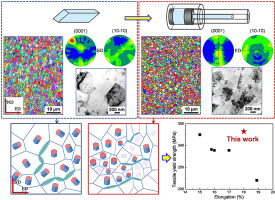当前位置:
X-MOL 学术
›
J. Alloys Compd.
›
论文详情
Our official English website, www.x-mol.net, welcomes your
feedback! (Note: you will need to create a separate account there.)
Development of high-performance Mg–Zn–Ca–Mn alloy via an extrusion process at relatively low temperature
Journal of Alloys and Compounds ( IF 5.8 ) Pub Date : 2020-06-01 , DOI: 10.1016/j.jallcom.2020.153942 L.B. Tong , J.H. Chu , W.T. Sun , Z.H. Jiang , D.N. Zou , K.S. Wang , S. Kamado , M.Y. Zheng
Journal of Alloys and Compounds ( IF 5.8 ) Pub Date : 2020-06-01 , DOI: 10.1016/j.jallcom.2020.153942 L.B. Tong , J.H. Chu , W.T. Sun , Z.H. Jiang , D.N. Zou , K.S. Wang , S. Kamado , M.Y. Zheng

|
Abstract In general, Mg alloys are difficult to process at low temperature (below 200 °C), due to the limited slip systems. High-temperature deformation easily results in the grain growth, which seriously restricts the improvement of mechanical properties. In this study, we report a subsequent low-temperature extrusion technology for ultra-fine grained (UFG) Mg–Zn–Ca–Mn alloys processed through equal channel angular pressing (ECAP), and successfully fabricate the extruded alloy with high yield strength (∼332.8 MPa) and superior ductility (∼17.9%) through grain refinement and texture modification. The initially fine-grained structure in the as-ECAPed alloy is beneficial to improving its low-temperature deformability, because the compatibility stress at grain boundaries can effectively promote the activation of the non-basal slip systems. Although the strength is dramatically increased, the alloy extruded at 100 °C exhibits the poor ductility, which can be ascribed to the dislocation accumulation behavior. With increasing extrusion temperature, the yield strength is remarkably increased at very small expense of ductility, because of the grain refinement, stacking faults, recovery of basal texture and fine secondary phase particles. The dislocations formed during the extrusion can be rapidly annihilated through a dynamic recrystallization process, which contributes to the improved ductility.
中文翻译:

通过相对低温挤压工艺开发高性能 Mg-Zn-Ca-Mn 合金
摘要 一般而言,镁合金由于滑移系统的限制,难以在低温(低于 200 °C)下加工。高温变形容易导致晶粒长大,严重制约了力学性能的提高。在这项研究中,我们报道了一种用于通过等通道角挤压(ECAP)加工的超细晶粒(UFG)Mg-Zn-Ca-Mn 合金的后续低温挤压技术,并成功地制造出具有高屈服强度的挤压合金( ∼332.8 MPa) 和优异的延展性 (∼17.9%) 通过晶粒细化和织构改性。as-ECAPed合金中的初始细晶结构有利于提高其低温变形能力,因为晶界处的相容性应力可以有效地促进非基础滑移系统的活化。尽管强度显着增加,但在 100 °C 下挤压的合金表现出较差的延展性,这可以归因于位错积累行为。随着挤压温度的升高,由于晶粒细化、堆垛层错、基底织构恢复和细小的二次相颗粒,屈服强度显着增加,但延展性的代价很小。挤压过程中形成的位错可以通过动态再结晶过程迅速消失,这有助于提高延展性。由于晶粒细化、堆垛层错、基底织构的恢复和细小的二次相颗粒。挤压过程中形成的位错可以通过动态再结晶过程迅速消失,这有助于提高延展性。由于晶粒细化、堆垛层错、基底织构的恢复和细小的二次相颗粒。挤压过程中形成的位错可以通过动态再结晶过程迅速消失,这有助于提高延展性。
更新日期:2020-06-01
中文翻译:

通过相对低温挤压工艺开发高性能 Mg-Zn-Ca-Mn 合金
摘要 一般而言,镁合金由于滑移系统的限制,难以在低温(低于 200 °C)下加工。高温变形容易导致晶粒长大,严重制约了力学性能的提高。在这项研究中,我们报道了一种用于通过等通道角挤压(ECAP)加工的超细晶粒(UFG)Mg-Zn-Ca-Mn 合金的后续低温挤压技术,并成功地制造出具有高屈服强度的挤压合金( ∼332.8 MPa) 和优异的延展性 (∼17.9%) 通过晶粒细化和织构改性。as-ECAPed合金中的初始细晶结构有利于提高其低温变形能力,因为晶界处的相容性应力可以有效地促进非基础滑移系统的活化。尽管强度显着增加,但在 100 °C 下挤压的合金表现出较差的延展性,这可以归因于位错积累行为。随着挤压温度的升高,由于晶粒细化、堆垛层错、基底织构恢复和细小的二次相颗粒,屈服强度显着增加,但延展性的代价很小。挤压过程中形成的位错可以通过动态再结晶过程迅速消失,这有助于提高延展性。由于晶粒细化、堆垛层错、基底织构的恢复和细小的二次相颗粒。挤压过程中形成的位错可以通过动态再结晶过程迅速消失,这有助于提高延展性。由于晶粒细化、堆垛层错、基底织构的恢复和细小的二次相颗粒。挤压过程中形成的位错可以通过动态再结晶过程迅速消失,这有助于提高延展性。











































 京公网安备 11010802027423号
京公网安备 11010802027423号